
- Physics Notes for UPSC IAS Prelims (Part I)
- Physics - Home
- Physics - Force and Pressure
- Physics - Friction
- Physics - Some Natural Phenomena
- Physics - Motion
- Physics - Force and Laws of Motion
- Physics - Gravitation
- Physics - Mass and Weight
- Physics - Work and Energy
- Physics - Light
- Physics - Reflection and Refraction
- Images Formed by Spherical Mirrors
- Physics - Refraction of Light
- Physics - Spherical Lenses
- The Human Eye & Colorful World
- Refraction of Light Through a Prism
- Physics - Electricity
- Chemical Effects of Electric Current
- Magnetic Effects of Electric Current
- Physics - Electric Motor
- Physics - Source of Energy
- Physics - Sound Part I
- Physics - Sound Part II
- Speed of Sound in Different Media
- Physics - The Solar System
- Physics - Stars and The Solar System
Physics - Spherical Lenses
Introduction
A transparent material (normally glass) bound by two surfaces, of which one or both surfaces are spherical, is known as "spherical lens."

Convex Lens
A lens may have two spherical surfaces, bulging outwards (as shown in the image given below), is known as convex lens or a double convex lens.
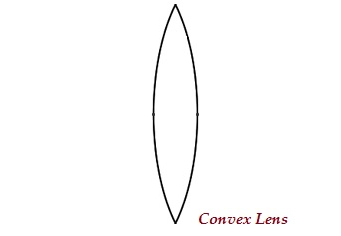
The middle part of this lens is bulged (thicker) and at the both ends, it is narrow.
Convex lens converges the light rays; therefore, it is also known as converging lens.
Concave Lens
A lens may have two spherical surfaces, curved inwards (as shown in the image given below), is known as concave lens or a double concave lens.
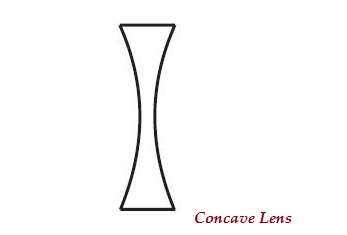
The middle part of this lens is narrow (curved inwards) and the both the edges are thicker.
Concave lens diverges the light rays; therefore, it is also known as diverging lens.
A lens, either a concave or a convex, has two spherical surfaces and each of these surfaces forms a part of the sphere. The centers of these spheres are known as centers of curvature, represented by English letter ‘C.’
As there are two centers of curvature, therefore, represented as ‘C1’ and ‘C2.’
An imaginary straight line, passing through both the centers of curvature of a lens, is known as principal axis.
Optical center is the central point of a lens. It is represented by ‘O.’
An aperture is the actual diameter of the circular outline of a spherical lens.
Principal focus of lens is represented by ‘F.’
A lens has usually two foci represented as F1 and F2.
Focal length is the distance between the principal focus and the optical center of a lens. It is represented by ‘f.’
The following table illustrates, the nature and position of images formed by a convex lens −
| Position of Object | Position of Image | Size of Image | Nature of Image | Image |
|---|---|---|---|---|
| At infinity | At the focus F2 | Highly diminished, pointsized | Real and inverted | 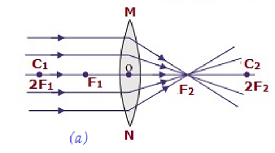 |
| Beyond 2F1 | B/w F2 and 2F2 | Diminished | Real and inverted | 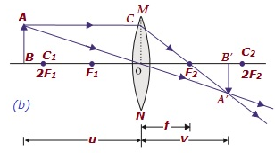 |
| At 2F1 | At 2F2 | Same size | Real and inverted | 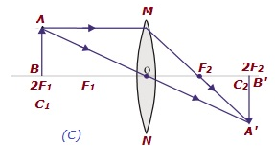 |
| B/w F1 & 2F1 | Beyond 2F2 | Enlarged | Real and inverted | 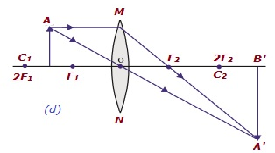 |
| At focus F1 | At infinity | Infinitely large or highly enlarged | Real & inverte d | 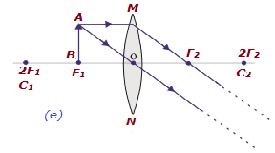 |
| B/w focus F1 & optical center O | On the same side of the lens as the object | Enlarged | Virtual and erect | 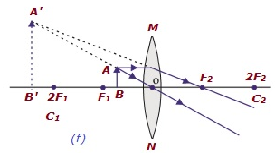 |
The following table illustrates, the nature and position of images formed by a concave lens −
| Position of Object | Position of Image | Relative Size of Image | Nature of Image | Image |
|---|---|---|---|---|
| At infinity | At the focus F1 | Highly diminishe d, pointsized | Virtual and erect | 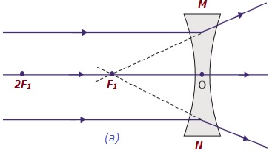 |
| B/w infinity & optical center O of the lens | B/w F1 & optical center O | Diminishe d | Virtual and erect | 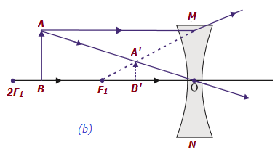 |
Lens Formula
The formula is expressed as −
Lens formula expresses the relationships among the object-distance (i.e. u), image-distance (i.e. v), and focal length (i.e. f) of a lens.
$$\frac{1}{v} - \frac{1}{u} = \frac{1}{f}$$